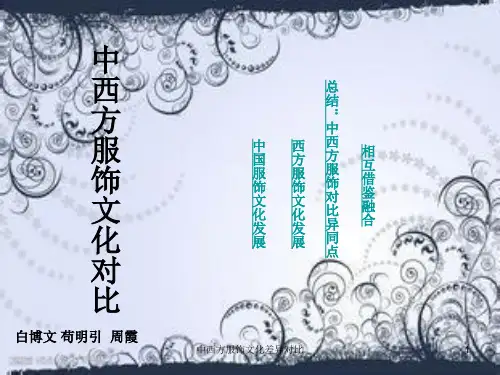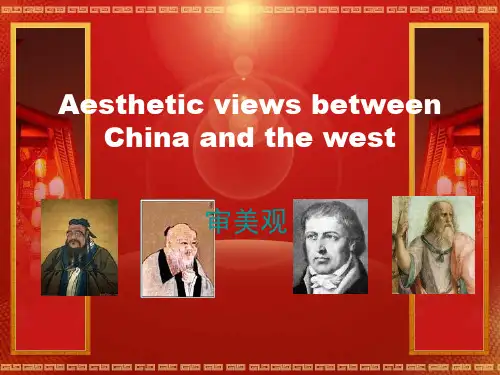中国和西方审美差异28页PPT
- 格式:ppt
- 大小:4.34 MB
- 文档页数:28
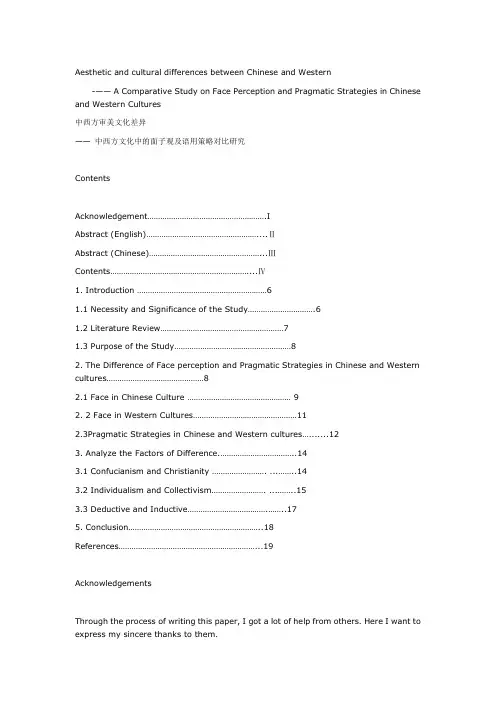
Aesthetic and cultural differences between Chinese and Western-—— A Comparative Study on Face Perception and Pragmatic Strategies in Chinese and Western Cultures中西方审美文化差异——中西方文化中的面子观及语用策略对比研究ContentsAcknowledgement (I)Abstrac t (English) (Ⅱ)Abstract (Chinese) (Ⅲ)Contents (Ⅳ)1. Introduction (6)1.1 Necessity and Significance of the Study (6)1.2 Literature Review (7)1.3 Purpose of the Study (8)2. The Difference of Face perception and Pragmatic Strategies in Chinese and Western cultures (8)2.1 Face in Chinese Culture (9)2. 2 Face in Western Cultures (11)2.3Pragmatic Strat egies in Chinese and Western cultures (12)3. Analyze the Factors of Difference (14)3.1 Confucianism and Christianity ......................... .. (14)3.2 Individualism and Collectivism......................... .. (15)3.3 Deductive and Inductive (17)5. Conclusion (18)References (19)AcknowledgementsThrough the process of writing this paper, I got a lot of help from others. Here I want to express my sincere thanks to them.First and foremost, my sincere gratitude goes to my respected supervisor, Prof. Ye Jing who has helped me throughout the process of writing this thesis with her timely advice and meticulous criticisms, overall direction and suggested revisions.Secondly I would like to thank all the teachers in our department, from whom we got to know how to do, how to learn and how to be. Through their earnest teaching of 4 years, I have acquired solid knowledge of English history and culture, and skills to learn more efficiently and independently. Meanwhile, I have learned how to behave myself as college student. I feel grateful to them all.Finally, I wish to give special thanks to all my classmates and friends, whose support has encouraged me to overcome many difficulties. Without their love and assistance, the accomplishment of this thesis would have been impossible.摘要面子观存在于人类的交往之中,但不同文化背景下对面子观的理解也有很多不同之处。
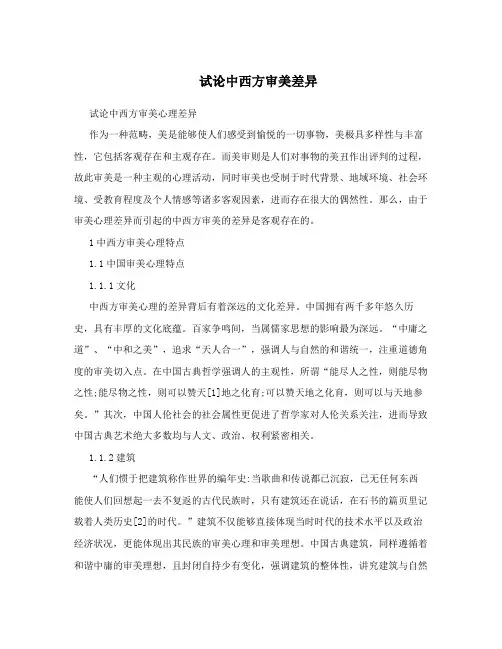
试论中西方审美差异试论中西方审美心理差异作为一种范畴,美是能够使人们感受到愉悦的一切事物,美极具多样性与丰富性,它包括客观存在和主观存在。
而美审则是人们对事物的美丑作出评判的过程,故此审美是一种主观的心理活动,同时审美也受制于时代背景、地域环境、社会环境、受教育程度及个人情感等诸多客观因素,进而存在很大的偶然性。
那么,由于审美心理差异而引起的中西方审美的差异是客观存在的。
1中西方审美心理特点1.1中国审美心理特点1.1.1文化中西方审美心理的差异背后有着深远的文化差异。
中国拥有两千多年悠久历史,具有丰厚的文化底蕴。
百家争鸣间,当属儒家思想的影响最为深远。
“中庸之道”、“中和之美”,追求“天人合一”,强调人与自然的和谐统一,注重道德角度的审美切入点。
在中国古典哲学强调人的主观性,所谓“能尽人之性,则能尽物之性;能尽物之性,则可以赞天[1]地之化育;可以赞天地之化育,则可以与天地参矣。
”其次,中国人伦社会的社会属性更促进了哲学家对人伦关系关注,进而导致中国古典艺术绝大多数均与人文、政治、权利紧密相关。
1.1.2建筑“人们惯于把建筑称作世界的编年史:当歌曲和传说都已沉寂,已无任何东西能使人们回想起一去不复返的古代民族时,只有建筑还在说话,在石书的篇页里记载着人类历史[2]的时代。
”建筑不仅能够直接体现当时时代的技术水平以及政治经济状况,更能体现出其民族的审美心理和审美理想。
中国古典建筑,同样遵循着和谐中庸的审美理想,且封闭自持少有变化,强调建筑的整体性,讲究建筑与自然相融合,以群体取胜并注重虚实结合。
柱、梁、斗拱等组成的木构架,轻盈通透,给人以灵动的观感;硕大的屋顶辅以漂亮的反曲线和轻巧多姿的翼角,给予建筑一种柔性的适应感,使之与山水林木等自然环境取得了相[3]当的和谐,无处不体现着“天人合一”的思想。
1.1.3审美意识(1)道德道德要素是影响审美情感的第一要素。
客观的审美事物在不同道德观念的审美主体面前,他们所反映出的审美评价定将不尽相同,甚至会截然相反。
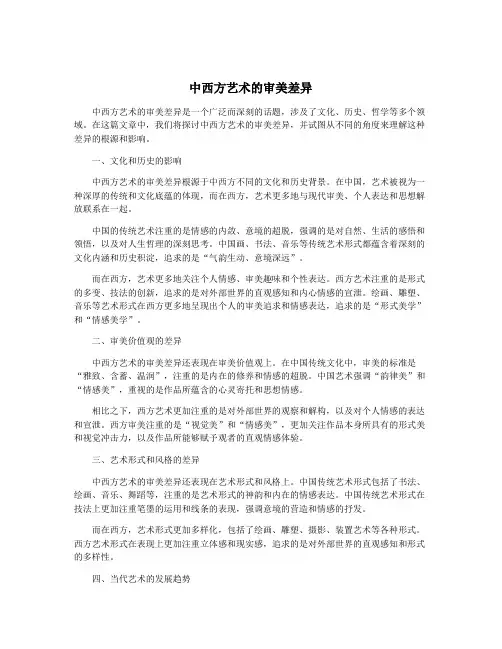
中西方艺术的审美差异中西方艺术的审美差异是一个广泛而深刻的话题,涉及了文化、历史、哲学等多个领域。
在这篇文章中,我们将探讨中西方艺术的审美差异,并试图从不同的角度来理解这种差异的根源和影响。
一、文化和历史的影响中西方艺术的审美差异根源于中西方不同的文化和历史背景。
在中国,艺术被视为一种深厚的传统和文化底蕴的体现,而在西方,艺术更多地与现代审美、个人表达和思想解放联系在一起。
中国的传统艺术注重的是情感的内敛、意境的超脱,强调的是对自然、生活的感悟和领悟,以及对人生哲理的深刻思考。
中国画、书法、音乐等传统艺术形式都蕴含着深刻的文化内涵和历史积淀,追求的是“气韵生动、意境深远”。
而在西方,艺术更多地关注个人情感、审美趣味和个性表达。
西方艺术注重的是形式的多变、技法的创新,追求的是对外部世界的直观感知和内心情感的宣泄。
绘画、雕塑、音乐等艺术形式在西方更多地呈现出个人的审美追求和情感表达,追求的是“形式美学”和“情感美学”。
二、审美价值观的差异中西方艺术的审美差异还表现在审美价值观上。
在中国传统文化中,审美的标准是“雅致、含蓄、温润”,注重的是内在的修养和情感的超脱。
中国艺术强调“韵律美”和“情感美”,重视的是作品所蕴含的心灵寄托和思想情感。
相比之下,西方艺术更加注重的是对外部世界的观察和解构,以及对个人情感的表达和宣泄。
西方审美注重的是“视觉美”和“情感美”,更加关注作品本身所具有的形式美和视觉冲击力,以及作品所能够赋予观者的直观情感体验。
三、艺术形式和风格的差异中西方艺术的审美差异还表现在艺术形式和风格上。
中国传统艺术形式包括了书法、绘画、音乐、舞蹈等,注重的是艺术形式的神韵和内在的情感表达。
中国传统艺术形式在技法上更加注重笔墨的运用和线条的表现,强调意境的营造和情感的抒发。
而在西方,艺术形式更加多样化,包括了绘画、雕塑、摄影、装置艺术等各种形式。
西方艺术形式在表现上更加注重立体感和现实感,追求的是对外部世界的直观感知和形式的多样性。


Aesthetic and cultural differences between Chinese and Western-—— A Comparative Study on Face Perception and Pragmatic Strategies in Chinese and Western Cultures中西方审美文化差异——中西方文化中的面子观及语用策略对比研究ContentsAcknowledgement (I)Abstrac t (English) (Ⅱ)Abstract (Chinese) (Ⅲ)Contents (Ⅳ)1. Introduction (6)1.1 Necessity and Significance of the Study (6)1.2 Literature Review (7)1.3 Purpose of the Study (8)2. The Difference of Face perception and Pragmatic Strategies in Chinese and Western cultures (8)2.1 Face in Chinese Culture (9)2. 2 Face in Western Cultures (11)2.3Pragmatic Strat egies in Chinese and Western cultures (12)3. Analyze the Factors of Difference (14)3.1 Confucianism and Christianity ......................... .. (14)3.2 Individualism and Collectivism......................... .. (15)3.3 Deductive and Inductive (17)5. Conclusion (18)References (19)AcknowledgementsThrough the process of writing this paper, I got a lot of help from others. Here I want to express my sincere thanks to them.First and foremost, my sincere gratitude goes to my respected supervisor, Prof. Ye Jing who has helped me throughout the process of writing this thesis with her timely advice and meticulous criticisms, overall direction and suggested revisions.Secondly I would like to thank all the teachers in our department, from whom we got to know how to do, how to learn and how to be. Through their earnest teaching of 4 years, I have acquired solid knowledge of English history and culture, and skills to learn more efficiently and independently. Meanwhile, I have learned how to behave myself as college student. I feel grateful to them all.Finally, I wish to give special thanks to all my classmates and friends, whose support has encouraged me to overcome many difficulties. Without their love and assistance, the accomplishment of this thesis would have been impossible.摘要面子观存在于人类的交往之中,但不同文化背景下对面子观的理解也有很多不同之处。

